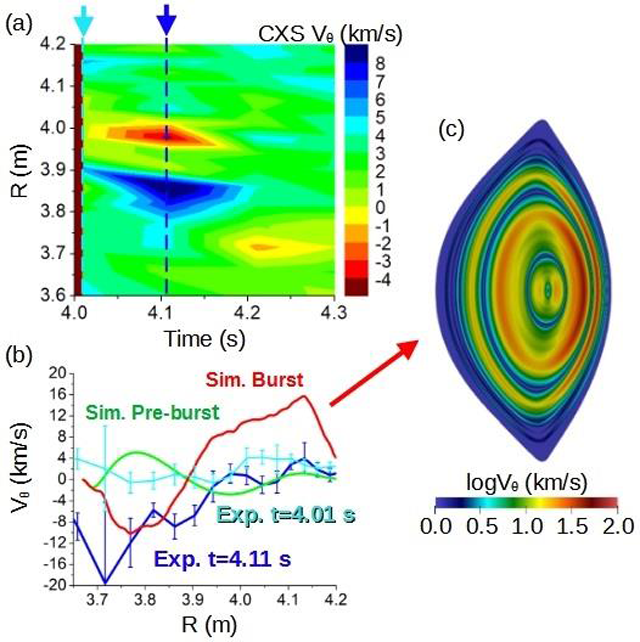Generation of shear flows induced by Alfven Eigenmodes and Energetic Particle driven Modes in LHD plasma
We have successfully analyzed the generation of shear flows induced by Alfven Eigenmodes and Energetic Particle driven Modes in LHD plasma. This result is consistent with recent observations in other devices and is expected to be beneficial for thermal plasma confinement in future fusion reactors and may lead to improved performance.

The plasma in future nuclear fusion reactors will be heated by neutral beam injectors (NBI) and high frequency electromagnetic waves, as well as fusion born alpha particles. Energetic particles (EP), with energies up to two orders of magnitude larger than the thermal plasma, can trigger instabilities called Alfven Eigenmodes (AE) and Energetic Particle Modes (EPM), inducing harmful EP losses that reduce the plasma heating efficiency and the economical viability of the reactor.
The generation of shear flows (SF) by Alfven Eigenmodes (AE) and Energetic Particle Modes (EPM) has important effects on the operation of future nuclear fusion reactors, because SF regulates the saturation of the AE/EPM, the transport of EPs and the confinement of the thermal plasma by reducing the turbulence, among other consequences.
The aim of this study is the analysis of SF generation during the saturation phase of the AE and EPM in LHD plasma. Experiments performed in the 23rd and 24th LHD experimental campaigns were dedicated to explore the destabilization of the AE and EPM in discharges with different heating patterns, thermal plasma and magnetic field configurations. Discharges #176490 and #179697 are selected for the analysis because strong AE and EPM activity is measured that may induce large SF. These discharges show the destabilization of burst events, abrupt plasma relaxations that release a significant amount of the plasma energy, particularly MHD bursts and energetic-ion-driven resistive interchange mode (EIC) bursts. Charge exchange spectroscopy (CXS) measurements in both discharges suggest the generation of SF during the burst event in the plasma region where the AE and EPM saturate, as can be see in panel (a) of the figure between the discharge times t = 4.0 to 4.2 s, once the MHD burst is destabilized in discharge #176490. Nonlinear simulations were performed using the gyro-fluid code FAR3d, dedicated to reproduce the experimental observations and confirmed that the burst events could generate strong SF. Panel (c) shows the generation of intense SF in the plasma region where the MHD burst was triggered in the simulation. To validate the model results, the thermal plasma poloidal velocity calculated by the simulations and measured in the experiment are compared in panel (b) before and after the MHD burst. Simulation and experimental data show a reasonable agreement, indicating an enhancement of the thermal plasma poloidal velocity in the inner-middle plasma region, once the MHD burst is destabilized.
In summary, the generation of shear flows by the AE or EPM could be beneficial for thermal plasma confinement in future nuclear fusion reactors, improving their performance. These results are in agreement with recent observation in other devices, such as the Joint European Torus (JET).
This research was conducted in collaboration with Dr. Jacobo Varela of University of Texas, Austin, USA, Dr. Carlos Hidalgo and Dr. Albaro Cappa of Laboratorio Nacional de Fusion-CIEMAT, Spain.
This research result was published in Nuclear Fusion, a journal on controlled thermonuclear fusion by the International Atomic Energy Agency, on December 18, 2024.
